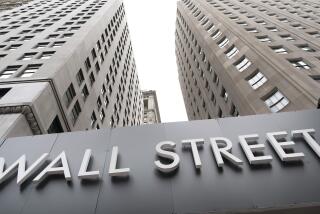New Issues Set a Record This Year : Securities: Initial public offerings of stocks and bonds hit $580 billion.
- Share via
NEW YORK — Corporate America issued a record $580 billion in stocks and bonds in 1991, leading a revival that helped end a four-year recession on Wall Street.
The resurgence was led by biotechnology and medical companies that offered stock to the public for the first time. Also, many companies taken private in leveraged buyouts in the 1980s were sold back to the public.
The total value of new stocks and bonds issued by American companies rose 86% from the previous record of $312 billion in 1990, IDD Information Services Inc. said Tuesday.
Stock offerings set the pace, more than tripling to $74.9 billion from $23.7 billion in 1990, according to IDD.
“People wanted to raise equity,” said Richard Franyo, an investment banker at Alex. Brown & Sons Inc. in Baltimore, the No. 1 company in underwriting initial public stock offerings.
“For years, more equity was coming out of the system than was going back in,” he said. “The market was receptive. So you had demand and you had supply.”
In underwriting, a central business on Wall Street, investment firms buy new stocks or bonds issued by companies and then resell them to investors.
The underwriting boom was a major reason the securities industry in 1991 finally recovered from the 1987 stock market crash. Wall Street is expected to report pretax profits of more than $4 billion, its best year since 1986.
Despite the recessionary economy, companies were encouraged to raise money by selling stocks and bonds because of a yearlong stock-market rally and lower interest rates.
“It’s taken the place of the robust mergers and acquisitions and merchant banking businesses” of the 1980s, Franyo said. “People have turned their forces to the business that’s available, and that’s raising equity.”
The biotechnology and medical industries had the most new stock issues. Such companies performed extremely well in the market after they were issued, encouraging other companies to raise capital as well.
According to IDD, the volume of initial public offerings by biotech companies rose 633%. Their stock prices gained an average of 57% after they were sold, the highest of any IPO category, IDD said.
Companies taken private in deals known as leveraged buyouts returned to the public domain in record numbers. By issuing new stock to the public, these companies reverse the LBO process in which a company’s stock is bought up with huge amounts of borrowed money.
The volume of reverse LBOs rose nearly nine times in 1991, to $5.2 billion from $600 million in 1990.
“It’s just a completion of the process that these deals undergo,” said Robert Natale, a new-issues analyst with Standard & Poor’s Corp. “The ones that go public are among the more successful leveraged buyouts.”
In 1991, those included battery maker Duracell Inc., clothing retailer AnnTaylor Stores Corp., container maker Owens-Illinois Inc. and AutoZone Inc., a car parts manufacturer. Federated and Allied department stores, recovering from a failed takeover, plan to offer stock to the public in early 1992.
The barrage of new offerings is continuing. The January calendar for deals is full, and the recent stock market rally is expected to attract more companies eager to capitalize on rising prices.
Medical and biotech offerings still crowd the field, but analysts said if the economy begins to recover the market can expect cyclical industries such as retailing, chemicals, steel and auto parts to return to the capital markets.
Merrill Lynch & Co. retained the top spot in overall underwriting for the fourth straight year, handling $100 billion in deals. Goldman, Sachs & Co. was second, and Lehman Bros. Inc. shot up to third from seventh.
Salomon Bros. tumbled to No. 7 from No. 4. The firm was engulfed in a bond-bidding scandal in the summer that led to criminal and civil investigations and a management overhaul.
Total underwriting fees for Wall Street firms more than doubled to $4.5 billion from $1.9 billion in 1990.
More to Read
Inside the business of entertainment
The Wide Shot brings you news, analysis and insights on everything from streaming wars to production — and what it all means for the future.
You may occasionally receive promotional content from the Los Angeles Times.










